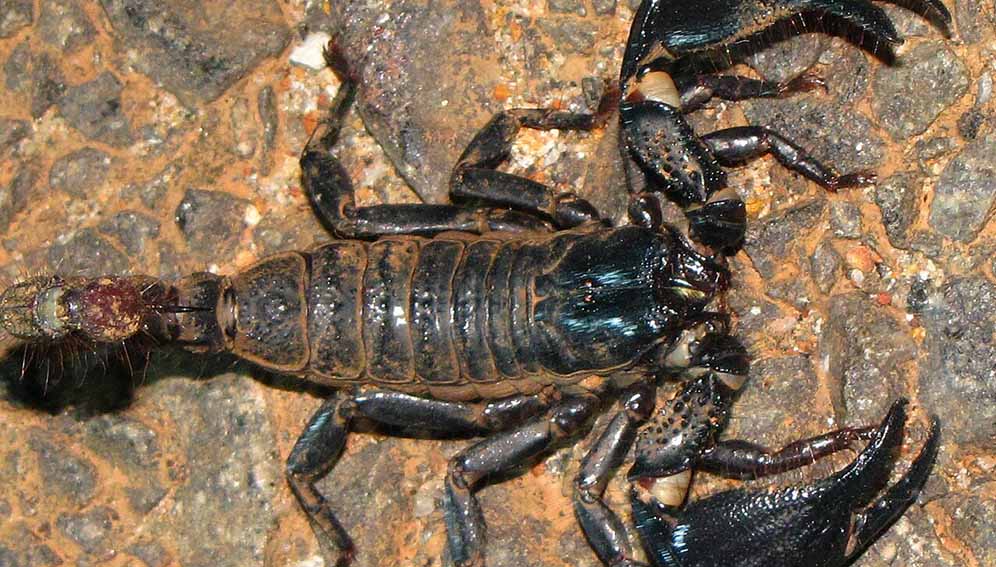[NEW DELHI, SciDev.Net] Researchers in India say they are close to creating an antivenom against the painful sting of the Indian black scorpion, which lurks in the undergrowth of the country’s forested areas.
Although scorpion stings are a global health concern, scorpion venom has attracted limited scientific scrutiny, leading to a poor understanding of its complex composition and toxicity, say the researchers whose study will be published in the September issue of the International Journal of Biological Macromolecules.
The glossy Indian black scorpion, or Heterometrus bengalensis, has inhabited the Earth for around 450 million years, and lives mainly in tropical and subtropical regions, including India, North Africa, Latin America, and the Middle East.
“This is a first step towards the goal of an antivenom that is effective for more than one species.”
Susmita Nath, researcher, Institute of Advanced Study in Science and Technology
About 1.2 million scorpion sting incidents are reported globally each year, resulting in around 3,250 deaths.
Delivered through a needle-like stinger at the tip of its long, flexible tail, scorpion venom can have severe side effects such as respiratory stress, cardiac dysfunction and multiple organ failure.
Treatment usually requires injections of antivenom, which can be expensive.
Currently, the standard treatment for scorpion sting, the F(ab’)2 antivenom, was developed by India’s state-run Haffkine Bio-Pharmaceutical Corporation to treat victims of the red scorpion (Buthus tamulus) sting.
However, scientists began to question whether species-specific antivenoms may be needed for more effective treatment.
|
Keep Science Journalism Alive SciDev.Net provides award-winning science news coverage free of charge. We rely on donations from readers like you to keep going. Donate to SciDev.Net today |
||
|---|---|---|
“While the primary focus of our research was black scorpion venom profiling, it offers a production roadmap for a safe and effective antivenom, the creation of which is ongoing at our laboratory at the Institute of Advanced Study in Science and Technology (IASST), Guwahati,” says Susmita Nath, a member of the research team.
“We have adequate initial data required to formulate and manufacture a viable antidote for H. bengalensis venom.”
The study, spearheaded by Ashis K. Mukherjee, director of IASST, used spectrometry — the measurement of interactions between light and matter — and biochemical analysis to uncover 25 distinct toxins across eight protein families in the venom, the basis of its danger to prey and humans.
Studying the effects of scorpion venom on Swiss albino mice, the researchers found that the chemicals led to systemic toxicity, increased liver enzymes, organ damage, and inflammation.
The venom triggered a toxic storm in the mouse’s system, causing liver enzyme levels to skyrocket, says Mukherjee.
“Organs showed signs of damage and the immune system went into overdrive — mounting a proinflammatory response that hinted at potential shock or severe allergic reactions in real-world stings,” he explained.
The findings, said Mukherjee, show the complexity of the black scorpion venom and highlight the urgency of improving therapeutic strategies, including the development of targeted, species-specific antivenom.
According to Mukherjee, scorpion venom is also being studied in other laboratories for its potential use in medicines. The venom contains peptides that can regulate the flow of ions in cells, act as an antimicrobial, or suppress the immune system to prevent it attacking healthy cells.
“Our study provides the first full venom profile of H. bengalensis and links the discovered toxins to systemic pathogenic consequences in a mammal,” said Nath.
“It lays a platform for further research into scorpion venom’s medicinal, toxicological, and ecological consequences, as well as helping to build a reference database of venom proteins for future investigations.”
According to Nath, since scorpion venom composition is species-specific, further research is needed to create an antivenom that is effective for multiple scorpion species.
“This is a first step towards the goal of an antivenom that is effective for more than one species,” she added.
Y K Gupta, president of the Society of Toxicology, India and known for his work on scorpion venom, says the sting carries a “complex mixture of toxins” that can make treatment difficult.
“Any work towards developing an effective antivenom for scorpion stings is therefore welcome,” said Gupta, who was not involved in the study.
This piece was produced by SciDev.Net’s Global desk.
